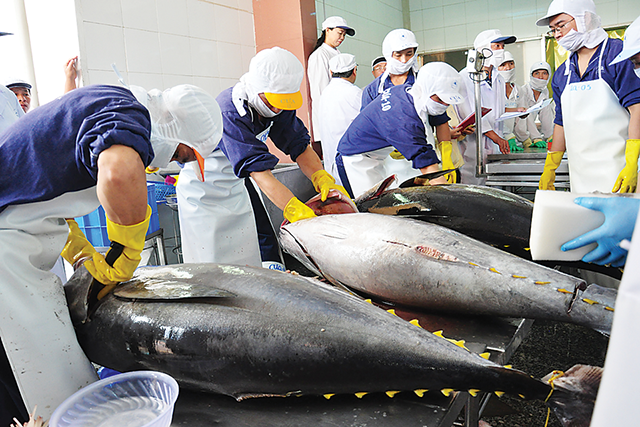In June 2025, Vietnam's tuna exports saw a sharp decline after a period of slowing growth. According to data from Vietnam Customs, tuna exports in June 2025 reached over USD 67 million, down 21% compared to the same period in 2024. However, the total value in the first six months of 2025 reached USD 473 million, nearly equivalent to the same period last year (a slight increase of 0.2%).
U.S. Market Slows Down
Due to concerns over potential new retaliatory tariffs from the U.S., many Vietnamese tuna exporters proactively suspended shipments to this market to avoid high tax risks. As a result, exports to the U.S. dropped sharply by 41% in June 2025 to USD 18 million. Despite the drop, the U.S. remains Vietnam’s largest tuna market, with a total value of USD 184 million in the first half of the year—accounting for nearly 39% of total tuna exports.

EU and CPTPP Markets: Diverging Trends
Along with the U.S., tuna exports to the EU bloc also continued to decline significantly in June, down 17% to just under USD 16 million. Cumulatively, tuna exports to the EU in the first half of 2025 increased only slightly—by nearly 1% year-on-year—reaching USD 109 million. Major markets in the region saw steep drops, such as the Netherlands (down 30%) and Italy (down 32%). Conversely, exports to Germany surged by 36% after three months of continuous decline. Weak economic conditions in Southern Europe and rising logistics costs are believed to be key factors affecting seafood consumption.
On the other hand, the CPTPP market recorded a positive growth of 11%, reaching USD 62 million. Notably, exports to Japan and Canada rose strongly by 24% and 15%, respectively—bright spots amid declines in major markets.
Strong Fluctuations in Niche Markets
Exports to smaller niche markets such as Israel, Russia, and Chile also declined sharply in June. Escalating conflicts in the Middle East are severely affecting tuna exports to this region, with shipments to Israel declining continuously over the first six months of the year.
Meanwhile, Thailand posted a remarkable increase of 137%, reaching USD 20 million—reflecting the country’s growing role as a processing and re-export hub.
Frozen Tuna Remains Key Export Product
Among exported tuna products, frozen tuna meat/loin (HS code 0304) recorded a strong 10% increase, reflecting stable demand from international food processors and supermarkets.
In contrast, processed tuna products (HS code 16) fell by 5%, mainly due to a sharp 14% drop in canned tuna exports. This clearly shows the impact of domestic raw tuna shortages, which are limiting exporters’ ability to fulfill orders—especially to the EU.
Vietnam’s Tuna Industry Faces Multiple Challenges
The revision of Decree 37/2024/NĐ-CP has been progressing too slowly. Although the Deputy Prime Minister has directed a fast-tracked revision process, the draft has yet to be issued. As a result, businesses are missing opportunities to capitalize on the tuna fishing season and continue to face legal and procedural risks. The proposed quota-based management approach in the revised decree is also raising concerns about increased administrative burdens and compliance costs.
Additional challenges stem from traceability regulations—including minimum catch size, bans on mixing domestic and imported raw materials, and strict documentation requirements for fishing vessels. These factors are forcing businesses to import tuna, reducing the use of Vietnamese-sourced materials—an essential condition to qualify for tariff preferences under the EVFTA.
Furthermore, the annual EVFTA tariff-free quota for processed and canned tuna (11,500 tons/year) is typically exhausted within the first 4–5 months of the year. Once this quota is filled, businesses face high MFN tariffs, reducing competitiveness and increasing the risk of losing EU buyers. In the early years of the EVFTA, 80–100% of Vietnam’s tuna exports benefited from tariff preferences. However, in the past two years, this rate has dropped drastically—sometimes to just 30%. The main reason is the inability to provide sufficient documentation to prove origin, and limited availability of products that meet the agreement’s rules of origin.
If existing obstacles related to Decree 37/2024/NĐ-CP are not resolved, the low rate of Vietnamese-origin tuna could result not only in reduced income for fishers and businesses but also negatively affect future quota negotiations with the EU post-2027.
Outlook for the Second Half of 2025
Given the current situation, Vietnam’s tuna exports are expected to face significant difficulties in the second half of the year, making it unlikely to reach the performance levels of 2024.





